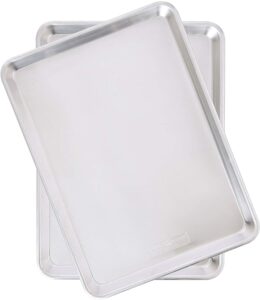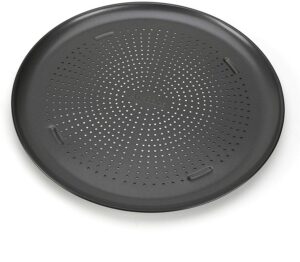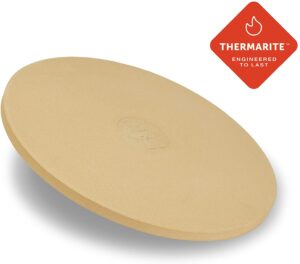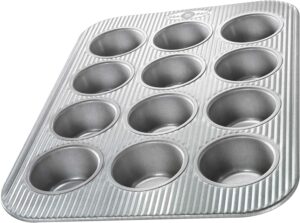Best Cookware
Best Cookware Set

Best Wok

Best Cookie Sheet

Best Pizza Pan

Best Pizza Stone

Best Muffin Pan

With a plethora of cookware styles, materials, and prices, it’s helpful to know what to look for based on your needs before you start your search. What kind of foods will you be cooking regularly? Do you want low-maintenance cookware that may not last as long, or something with more upkeep that will last you for years? These are all important questions to keep in mind as you start your search.
Types of cookware
Stainless steel
Stainless steel cookware is one of the most popular types you’ll find on the market. It doesn’t rust or stain, can handle high heat, doesn’t react to foods while cooking, can be used on induction cooktops — plus it’s dishwasher safe. Stainless steel is typically on the pricier side of cookware, but it’s versatility and durability make it worth the price tag.
Aluminum
Uncoated aluminum is not an ideal choice for cookware, but coated aluminum is great — non-stick materials bond to it easily to protect and make the coating more durable. Most non-stick aluminum is dishwasher safe (definitely check with the manufacturer first), but it can’t be used on induction cooktops unless the cookware has stainless steel on the bottom.
Cast iron
Cast iron is a heavy duty material that retains heat well and will keep food warm after cooking is done. Cast iron cookware can be either coated or uncoated, but both are induction-cooktop friendly.
Uncoated cast iron cookware comes pre-seasoned and is practically indestructible, but needs some special care and cleaning — it can only be washed by hand after each use and will occasionally need to be re-seasoned.
Coated cast iron cookware never needs seasoning and it’s safe for use with acidic foods. Its exterior will be shinier in color but has a rough matte interior that resembles uncoated cast iron. Some coated cast iron cookware may be dishwasher safe, but always check with the manufacturer since some detergent could damage the coating.
Non-stick
Non-stick cookware is usually the best bang for your buck. It’s typically just aluminum cookware with non-stick coatings, making them easy to clean and fine for use on any cooktop. However, the non-stick coating will end up chipping, scratching, or wearing away after regular use so these pots and pans won’t last you very long and will need replacing more frequently.
Non-stick materials sometimes get a bad rap, but nonstick cookware is perfectly safe so long as the pieces made with Teflon are not heated above 500ºF.
What else to look for when buying cookware
Size and shape
It all comes down to personal preference to choose the perfect sizes of cookware — it depends on how many people you’re cooking for, how much food you want to make, and what kind of food you’re making. Small cookware will work for individual meals, but some may prefer large cookware to cook for the family, or cook ahead and freeze meals for meal planning.
It’s also important to consider how the cookware feels in your hands as you cook. Not so heavy that it’s hard to maneuver, but not so light that it’ll slide all over the stove top. You want to be comfortable while you cook. Some cookware has silicone-wrapped handles that stay cooler to the touch than metal handles. You can also look for an extra handle on the opposite side of the main one, called a helper handle, for added stability when moving the pieces around.
Washing/Maintenance
Each material of cookware comes with its own level of maintenance. Dishwasher-safe cookware is time- and energy-saving, but may not last as long as materials needing a little more upkeep. Some coatings may wear out faster with repeated cleanings, like non-stick materials. Materials like copper and cast iron, for example, usually require more maintenance to keep them in tip-top shape, while stainless steel and aluminum are generally much easier to look after.
Heat conduction and reactivity
Heat conduction refers to how well your cookware transfers heat from the stovetop to the food. Each material heats differently and the level of your burner may need to be adjusted accordingly, especially depending on the food being cooked.
Reactivity determines whether your cookware will react chemically with the food that’s being cooked. It can cause an unwanted change in the food’s color or taste — in other words, we don’t want any reactivity with our pots and pans. Non reactive materials include stainless steel, ceramics, and coated cast iron, while copper, steel, iron, and aluminum are considered reactive materials.
Best Cookware Set

This kitchen cookware set is made with durable aluminum that retains the perfect amount of heat, is scratch resistant, and won’t react to acidic foods. The toxin-free, long-lasting non-stick coating easily handles everyday use and allows for an easier cooking time and cleanup. A unique ring around the pots and pans act as a thermo spot indicator, turning red to show when they’re perfectly heated and ready for the food to be added. Each piece is designed with riveted silicone handles and vented tempered glass lids for extra comfort and ease while cooking.
Best Wok

Made of 18/10 stainless steel and an aluminum core, this wok has the durability of steel and the even heat distribution of aluminum. The solid stainless steel riveted handles are built with air-flow technology to keep them cool while you cook, unlike typical steel handles, and the secure-fitting dome lid traps in heat and moisture for the perfect cooking conditions. The exterior is scratch resistant, and it’s dishwasher safe to make cleaning up a breeze.
Best Cookie Sheet

This durable aluminum cookie sheet is made of pure aluminum, so you will never have to worry about it rusting throughout its lifetime of use. The aluminum also allows for superior heat conductivity and a natural non-stick material, leaving you with evenly baked foods and an easy clean up. A reinforced steel rim keeps the sheets from warping, so you can be sure it’ll stand up to regular use. Even with the strong aluminum outer, it’s recommended to avoid the dishwasher and hand wash after each use.
Best Pizza Pan

Baking a pizza at home has never been easier than with this nonstick pizza pan. The nonstick aluminum outer is perforated to promote a faster, more even heating of the crust, leaving you with a perfectly crisp pizza that easily slides off the pan when done. It’s recommended to wash and condition the pan prior to first time use, avoid using metal utensils to prevent scratching, and be sure to hand wash after every use.
Best Pizza Stone

Cook the crispiest restaurant-quality pizzas with this Thermarite pizza stone. Thermarite is an extremely durable and strong stone material with superior heat retention. It is designed with micropores that absorb more moisture out of pizza dough, giving you the best crispy crusts. Take it with you anywhere thanks to its versatility of being used in ovens or on grills. It is odorless, is safe on all foods, and makes clean up easy so you can spend more time enjoying your delicious pizza.
Best Muffin Pan

This cupcake and muffin pan has 12 standard size wells made from heavy duty aluminized steel. It features an Americoat silicone coating (which is PTFE, PFOA, and BPA free) to promote a nonstick outer for quick and easy clean up. The unique fluted surface design enhances the nonstick qualities and adds strength to resist warping from regular use. The aluminized steel allows for perfect heat distribution and increased air flow, so you’re guaranteed with evenly baked goodies. When done, simply wash with hot water, mild soap, and a gentle scrub brush or sponge.
FAQs about Cookware
Is expensive cookware really that much better?
Price isn’t everything when it comes to cookware. There are high-priced pieces that aren’t very durable or are constructed poorly. On the other hand, there are inexpensive pieces that are more reliable and overall better made. Rather than focus on price, look for cookware that is sturdy and is made of a metal that works with what you’ll be cooking. However, if you cook frequently and want to invest in high-quality cookware, the higher price tag will be well worth it.
When should I replace my cookware?
A typical rule of thumb is to replace your pots and pans every five years or so. Be sure to check on the quality of your cookware frequently — when they start to appear warped, discolored, or scratched, it’s time to stop using them and purchase replacements.
Is it okay if my pizza stone has stains?
Stains on pizza stones (and all other porous types of cookware) are perfectly normal — in fact, your stone will likely earn many more stains and marks from regular use. The marks and stains will not affect its performance whatsoever, and many cooks even prefer a pizza stone with a lot of use!

